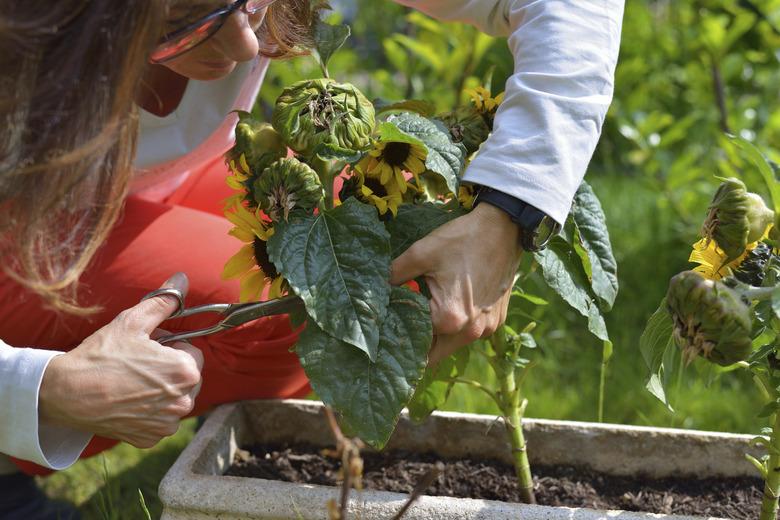How To Deadhead Sunflowers
The annual sunflower (Helianthus annuus) and perennial sunflowers (Helianthus spp., USDA zones 3 through 9), provide bright yellow, white, orange and burgundy flowers in the garden. While some of the annual cultivars produce the large seed heads that wildlife and humans enjoy, the perennials are suitable for both borders and backdrops, depending on the species, cultivar and size. You might enjoy your sunflower plants as they are, but when you deadhead sunflowers, and other flowers, it helps you enjoy their future blooms even longer.
Why Deadhead Sunflowers?
A simple reason exists to remove the fading flowers of sunflowers and lots of other plant varieties: Doing so keeps the blossoms coming on some types of sunflowers. A flowering plant's purpose is to propagate by producing flowers and seeds. When you remove fading flowers before a sunflower starts producing seeds, it signals the plant to produce more flowers.
Deadheading has other advantages. For example, removing the fading flowers can make the plants look tidier. If you don't want sunflowers growing from seeds on their own in the same garden next year, then deadhead to prevent the seeds from forming and dropping into the garden soil.
Sanitize Your Tools
A sharp knife, scissors or a pair of hand pruners should do the job of deadheading sunflowers well. Because you're cutting plants that you want to remain alive and healthy, disinfect your cutting tools before you begin deadheading. If you don't, you could spread diseases from one plant to another.
Before you deadhead sunflowers, wipe the blades of your pruning tool with isopropyl alcohol (at least 70 percent) or a household cleaner, such as Lysol or Pine-Sol. You can also soak your tools in the solution for five minutes and then rinse them with clean water. Allow them to air dry. Avoid using chlorine bleach; it pits the metal blades of your tools.
Before you start, put on safety goggles, gloves and long sleeves. The prickly stems of some sunflower cultivars may scratch your hands and arms as you work amid the stems and foliage.
When to Deadhead
As a general rule, deadhead sunflowers when they start to fade or when they are damaged and no longer attractive, before they produce seeds. When a sunflower's flower head stops looking as vibrant as it once did or when its yellow ray petals have fallen off, select it for deadheading. Also deadhead blooms that were chewed by insects or otherwise look withered. On multi-stemmed sunflower varieties, remove less-vigorous flowers to give other blossoms more room to grow.
If you want to save the sunflower seeds that form in the center of the flower heads, then don't deadhead the flowers until their backs start to turn yellow. Cut the flower head off, leaving about 12 inches of stem, then use garden twine to hang it in a dry, well-ventilated space to allow its seeds to mature. Depending on how late in the growing season it is, a sunflower plant may not produce new blooms after its flower heads are removed.
Make the Cuts
Deadheading sunflower blooms is fairly simple. Look down the stem from a bloom you want to remove, and locate the first set of leaves. If the sunflower is a multistem variety, look down a faded bloom's stem to find the location of a new lateral flower or stem.
Grasp the stem firmly. Make a slightly angled cut below the flower about 1/2 inch above the first set of leaves, new lateral flower or stem. Angle each cut so the remaining stem points somewhat toward the sky.
If the growing season is long enough in your area and your sunflowers continue to thrive, then you might get the chance to make yet another deadheading cut on the same plant, once again cutting the old growth back to the first set of leaves, new lateral flower or stem.
